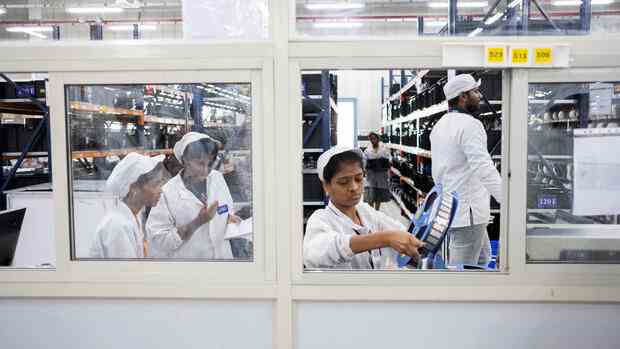India has recently been considered an important motor for the global economy.
(Photo: Bloomberg/Getty Images)
Bangalore India’s economic growth is weakening noticeably: In the last quarter of 2022, Asia’s third-largest economy grew by only 4.4 percent compared to the previous year, according to the country’s statistics authority. That’s less than analysts expected – and also a significantly lower value than the growth rate of 6.3 percent in the previous quarter.
The country with a population of 1.4 billion, which was recently considered an important engine for the global economy, missed its goal of being the fastest growing G20 country for the second quarter in a row. Both Saudi Arabia and Indonesia reported growth in economic output of more than five percent for the period from October to December. In 2022 as a whole, Saudi Arabia was also ahead with a growth rate of 8.7 percent – driven by the good oil business. India is expecting a growth rate of around seven percent for the current fiscal year, which lasts until the end of March.
Afterwards, however, India’s economy should bring the country back to the top of the world: The International Monetary Fund (IMF) then assumes a growth rate of around six percent. According to IMF forecasts, India will account for 15 percent of global economic growth.
Economists see the slowdown in the Indian economy as a result of higher key interest rates and weak export business, among other things. To combat inflation, the central bank raised interest rates by 2.5 percentage points last year.
Rate hikes as another downside risk
“There are signs that higher interest rates are having an impact on the real economy,” commented Shilan Shah, India economist at analyst firm Capital Economics. Both private consumption growth and investment growth have declined “most likely in response to higher interest rates.” A slight increase in government spending could not have compensated for this.
>> Read here: The hyped India as a land of unlimited difficulties
Rupa Rege Nitsure, chief economist at Indian financial services firm L&T Finance, sees additional downside risk from “possible further rate hikes combined with a slowdown in aggregate demand”. Kunal Kundu, India analyst at French bank Société Générale, noted that the real value of consumption remains little above pre-Covid-19 levels.
Analysts expect the central bank to hike interest rates by a further 0.25 percentage points in the coming months – despite growing criticism of the course. Economist Jayanth Varma, who is an outside member of the central bank’s monetary policy committee, complained at a recent meeting that monetary policy had become sluggish in relation to growth, according to minutes. “I sincerely hope we won’t pay the price in the form of unacceptably low growth,” he added. However, he represented a minority opinion within the committee.
Bad news for the German economy
India’s inflation rate stopped the downward trend of the past few months in January and rose to 6.5 percent. It was again above the central bank’s target range of up to six percent. The next inflation data, which will be published in mid-March, will point the way for further monetary policy.
India is also suffering from the weakness of the global economy – especially in the important export market USA. In January, the value of India’s merchandise exports fell 6.6 percent from a year earlier. In December, exports had already fallen by 12.2 percent. Economist Varma warned in a recent interview that “all sources of demand in the economy could shrink at the same time”.
Should concerns about weaker economic growth in India prove true, that would also be bad news for the German economy. German entrepreneurs are currently making targeted efforts to strengthen their presence in India – also to reduce their dependence on the Chinese market.
During a visit to India at the weekend, Chancellor Olaf Scholz said about the commitment of German industry that the intention was that “investments be expanded and the number of employees massively increased”. He was accompanied on the trip to the emerging country by a high-ranking business delegation. “We want and must use the potential that exists here,” said Scholz.
More: Free trade agreement: Olaf Scholz wants to intervene in negotiations with India

